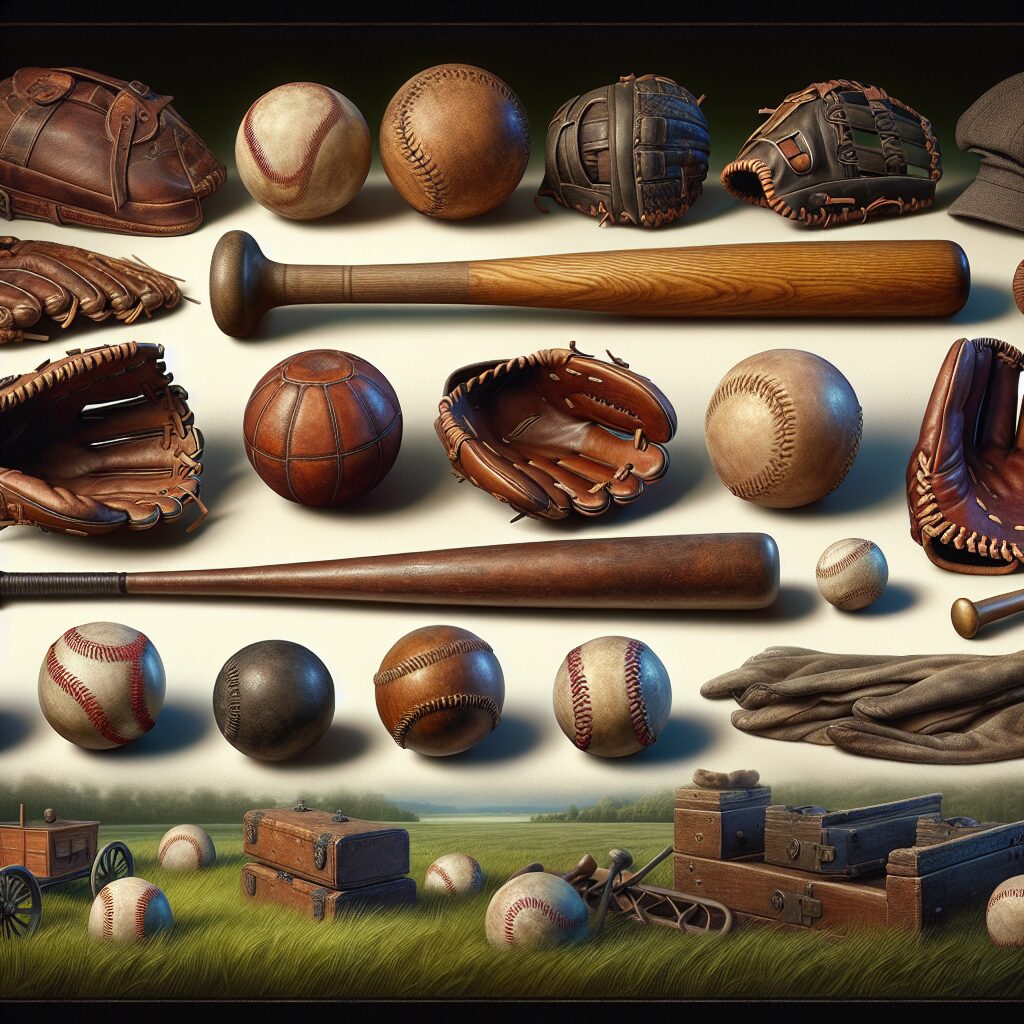The Evolution of Equipment in Early Ball Games is an intriguing topic that delves into the fascinating changes and advancements in the gear used in these early forms of sport. Dating back centuries, these ball games played a significant role in various cultures across the globe, from ancient civilizations to indigenous tribes. It is remarkable to explore how the equipment used in these early ball games not only shaped the sport but also reflect the cultural and technological advancements of their time.
One intriguing insight into the evolution of equipment in early ball games is the diversity of materials used. In ancient times, people improvised and utilized natural resources readily available to them. For instance, in ancient Egypt, one of the earliest ball games was played using a ball made from tightly woven papyrus reeds. This unique use of materials showcases the resourcefulness and creativity of early civilizations. As time progressed, advancements in craftsmanship allowed for the development of more durable and versatile equipment. From animal bladders to leather balls, the evolution of materials played a pivotal role in enhancing the playing experience and opening up new possibilities for game strategies.
Moving forward, it is essential to examine the key takeaways from the historical evolution of equipment in early ball games. By gaining an understanding of the advancements in gear used in these ancient sports, we can appreciate the ingenuity and resourcefulness of our ancestors. Additionally, studying the changes in equipment sheds light on the cultural and societal influences that shaped these games. In the following sections of this article, we will delve deeper into various historical examples, exploring the specific impacts and unique features of the different types of equipment used in early ball games.
Key Takeaways
1. Early ball games, such as ancient Egyptian and Mayan versions, featured minimal equipment, primarily utilizing the human body for play.
2. Over time, ancient ball games in different cultures started incorporating simple equipment like sticks, paddles, or rackets to enhance gameplay and increase the challenge.
3. Ancient Greece and Rome marked a significant shift in the development of ball game equipment, with the introduction of leather-covered balls and the use of specialized nets or baskets for gameplay.
4. Medieval Europe witnessed the emergence of more structured ball games, requiring specific equipment like balls made of wood or leather, elaborate goals or targets, and even protective gear, such as hand guards or padded gloves.
5. The evolution of equipment in early ball games not only improved the game itself but also reflected the social, cultural, and technological advancements of the societies in which these games were played.
What is the Impact of The Evolution of Equipment in Early Ball Games?
1. The Significance of Equipment in Ball Games
In early ball games, equipment played a crucial role in shaping and transforming the sport. From the very beginning, players have relied on various tools and gear to enhance their performance and improve the overall playing experience.
2. The Origins of Ball Game Equipment
The evolution of equipment in early ball games can be traced back to ancient civilizations. Different cultures developed unique equipment to suit their specific ball games. Examples include the use of wooden bats, stone balls, and even early forms of protective gear.
3. Technological Advances and Innovations
Over time, technological advancements significantly impacted the evolution of ball game equipment. Innovations such as the introduction of synthetic materials, improved bat designs, and specialized footwear have revolutionized the way the game is played.
4. Influence on Gameplay and Performance
The evolution of equipment has had a profound influence on the gameplay and performance in early ball games. Improved equipment has allowed players to hit the ball harder, throw with more accuracy, and protect themselves from potential injuries. This, in turn, has led to more thrilling and competitive matches.
5. Cultural and Societal Impact
The changes in equipment used in early ball games also reflect the cultural and societal shifts throughout history. It demonstrates how sports have evolved as an integral part of human civilization and how equipment has become a symbol of progress and innovation.
6. Preservation and Exhibition of Historical Equipment
Preserving and showcasing historical ball game equipment allows us to appreciate the evolution of sports and the craftsmanship of the past. Museums and exhibitions provide a glimpse into the early stages of ball games, giving us a deeper understanding of their development.
7. The Future of Ball Game Equipment
As technology continues to advance, we can expect further innovation in ball game equipment. From augmented reality training tools to advanced protective gear, the future of equipment in ball games holds exciting possibilities, enhancing both the player experience and the audience engagement.
Concluding Recommendations:
1. How can players embrace the advancements in equipment?
- Stay updated with the latest equipment developments and technologies.
- Consider incorporating new gear into training routines to improve performance.
- Seek professional guidance on how to adapt to new equipment effectively.
2. How can historical equipment be preserved?
- Support museums and exhibitions dedicated to the preservation of sports history.
- Donate or lend historical equipment to relevant institutions.
- Document and record the significance and origins of equipment to ensure its legacy.
3. What should be considered in future equipment development?
- Ensure safety measures are integrated to minimize the risk of injuries.
- Promote inclusivity by designing equipment suitable for players of diverse physical abilities.
- Conduct thorough research and testing to validate the effectiveness of new equipment.
Frequently Asked Questions
1. What types of ball games were played in ancient times?
Ancient civilizations played various ball games, including Mesoamerican ball games like the Mayan ballgame, Roman ball games like harpastum, and early forms of cricket and baseball.
2. How have the rules of ball games evolved over time?
The rules of ball games have evolved significantly throughout history to accommodate changes in equipment, technology, and cultural influences. For example, the introduction of gloves and protective gear in baseball altered gameplay strategies and safety measures.
3. What were some of the earliest equipment used in ball games?
Early ball games often involved basic equipment such as balls made of animal bladders, rocks, or stitched leather. Sticks, branches, or bare hands were commonly used to strike or catch the ball.
4. When did specialized equipment start to appear in ball games?
Specialized equipment started to appear in ball games during the medieval period. The use of racquets in early variations of tennis and the introduction of wooden bats for cricket indicate the emergence of more refined equipment.
5. How did the Industrial Revolution impact the evolution of ball game equipment?
The Industrial Revolution led to the mass production of sporting goods, making equipment more readily available and affordable. This resulted in increased participation in ball games and further fueled the evolution of equipment designs and materials.
6. What contributions did early ball games make to the development of modern sports equipment?
Early ball games played a crucial role in shaping the development of modern sports equipment. Innovations such as the introduction of rubber balls, the design of cricket bats, and the creation of standardized baseballs paved the way for the equipment we use today.
7. How did the evolution of equipment in ball games impact the safety of players?
The evolution of equipment in ball games has significantly improved the safety of players. The introduction of protective gear like helmets, shin guards, and chest protectors in various sports has reduced the risk of injuries and enhanced player safety.
8. Are there any notable examples of how technology has influenced the evolution of ball game equipment?
Absolutely! Technological advancements have revolutionized ball game equipment. Examples include the use of lightweight materials like carbon fiber in tennis rackets, the development of high-performance basketball shoes, and the implementation of advanced tracking systems in sports balls.
9. What factors have influenced the design and materials used in ball game equipment?
The design and materials used in ball game equipment are influenced by factors such as player performance, comfort, safety requirements, cultural practices, technological advancements, and market demands.
10. How do the evolving equipment trends impact the future of ball games?
The evolving equipment trends in ball games will continue to shape the future of these sports. As technology advances and new materials are discovered, we can expect further modifications to equipment designs, improved performance, and an enhanced overall experience for players and fans.
Final Thoughts
The Evolution of Equipment in Early Ball Games
The fascinating journey of ball game equipment from its humble beginnings to the sophisticated gear we witness today is a testament to human ingenuity and the ever-changing nature of sports. The constant pursuit of improvements in ball game equipment has not only elevated the playing experience but also played a vital role in the growth and popularity of various sports around the world.
As we delve deeper into the history and evolution of ball games, it becomes evident that equipment innovation goes hand in hand with the evolution of gameplay, rules, and player safety. The future of ball games is bound to witness more groundbreaking advancements in its equipment, ensuring that athletes can continue to push their limits, break records, and thrill audiences for generations to come.




